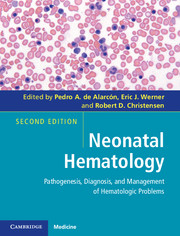Book contents
- Frontmatter
- Contents
- Contributors
- Foreword
- Preface
- 1 A historical review
- Section I Developmental hematology
- Section II Erythrocyte disorders
- Section III Platelet disorders
- Section IV Leukocyte disorders
- Section V Immunologic disorders
- Section VI Hemostatic disorders
- 16 Neonatal Thrombosis
- 17 Bleeding disorders
- Section VII Transfusional medicine
- Section VIII Miscellaneous
- Index
- Plate section
- References
16 - Neonatal Thrombosis
from Section VI - Hemostatic disorders
Published online by Cambridge University Press: 05 February 2013
- Frontmatter
- Contents
- Contributors
- Foreword
- Preface
- 1 A historical review
- Section I Developmental hematology
- Section II Erythrocyte disorders
- Section III Platelet disorders
- Section IV Leukocyte disorders
- Section V Immunologic disorders
- Section VI Hemostatic disorders
- 16 Neonatal Thrombosis
- 17 Bleeding disorders
- Section VII Transfusional medicine
- Section VIII Miscellaneous
- Index
- Plate section
- References
Summary
Introduction
Although the newborn infant is born with an immature coagulation system, the well term and preterm infant rarely experiences bleeding or clotting. However, the neonate has very limited capacity to respond to hemostatic stresses and quickly develops severe acquired deficiencies of coagulation proteins, especially in the face of sepsis or hypoxia. Infection and associated inflammation, through reciprocal activation of coagulation, results in the consumption of protein C and other proteins, ultimately causing both thrombosis and bleeding. Infection and indwelling catheters promote thrombosis in a facilitative manner. Genetic thrombophilia also promotes thrombosis in the neonate, especially idiopathic thrombosis, and should be considered in the evaluation of a newborn infant with thrombosis. Imaging techniques for neonatal thrombosis range from Doppler and imaging ultrasound for extremity arterial and venous thrombosis, to magnetic resonance angiography for arterial ischemic stroke and cerebral sinovenous thrombosis. Risks for death, recurrence and long-term complications of thrombosis can be used to determine aggressiveness of antithrombotic approach required. Finally, dosing of antithrombotic agents is unique to this developmental age and cannot be extrapolated from older children or adults.
Bulleted list of salient points (5–10)
Thrombosis is a significant clinical problem in the newborn nursery affecting both term and preterm infants.
Most newborn infants presenting with thrombosis have predisposing underlying disorders and triggers.
Sepsis is a powerful promoter of prothrombotic hemostatic alterations resulting in DIC and thrombosis.
Genetic thrombophilia contributes to the thrombotic tendency of the newborn.
The imaging technique used to diagnose thrombosis in the newborn is dependent upon the anatomic site of the thrombus.
Newborn infants with thrombosis can be stratified by risk for poor outcome; antithrombotic therapies form a continuum from least to most aggressive approach that is dictated by clinical circumstances and patient factors.
Dosing of antithrombotic agents in the newborn is unique to the developmental age of the infant and competence of the hemostatic system.
- Type
- Chapter
- Information
- Neonatal HematologyPathogenesis, Diagnosis, and Management of Hematologic Problems, pp. 277 - 285Publisher: Cambridge University PressPrint publication year: 2013

